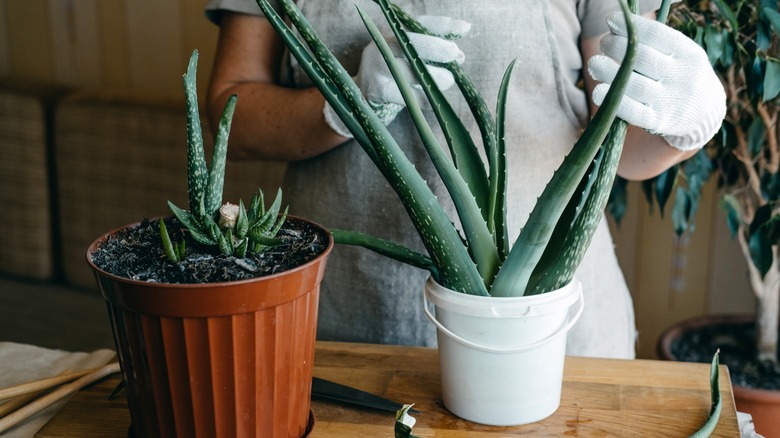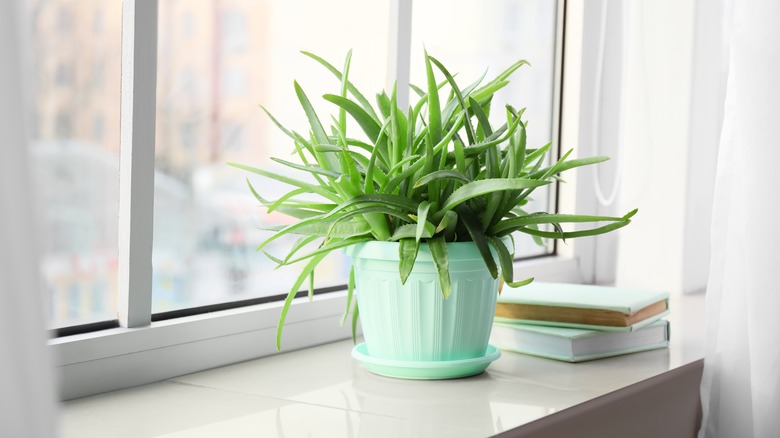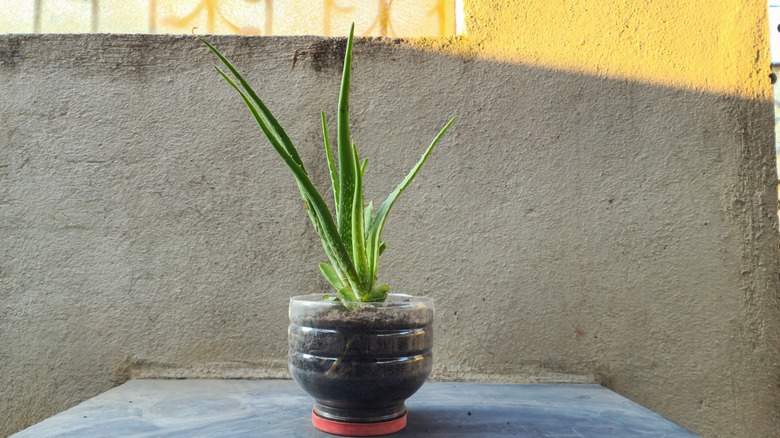Think Twice Before Planting Aloe Vera In Your Garden
Aloe vera's reputation as a hardy and advantageous houseplant probably appeals to you if you're considering planting it. It's true that aloe vera is often lauded for being nearly indestructible under the right conditions: adequate watering and plenty of sunshine. But before you make space for it in your garden, it's crucial to consider some less-known aspects of this popular plant. While growing aloe vera is pretty straightforward since it is often hailed for its easy care and numerous health benefits (especially when used topically), its toxicity when ingested is a significant concern. The same succulent leaves that are a source of beneficial gel can pose a risk if consumed. It's a paradox — a plant celebrated for its healing properties can be harmful if ingested. Aloe vera's dual nature necessitates caution and awareness, especially if your garden is where curious pets or young explorers frequent.
Additionally, while not overly demanding, aloe vera's care requirements call for specific conditions to thrive. While hardy, the plant comes with challenges that extend beyond its toxic nature. This plant has specific sunlight requirements and is susceptible to various pests and diseases. Understanding these challenges is key to successfully integrating aloe vera into your garden without unwanted complications. You'll need to carefully think about its placement and the overall safety of the garden space, especially if it's an area shared with pets and children.
Navigating the sunlight needs and pest challenges of aloe vera
Aloe vera thrives in bright, direct sunlight, needing a minimum of six hours of sun exposure daily. Without this level of sunlight, your aloe plant can become elongated and weak, losing the lush, green appearance that makes it so appealing. You'll have to find the perfect spot for your plant. However, this can be a bit of a balancing act. While it loves sunlight, too much direct exposure in scorching climates can harm the plant, causing the leaves of your aloe vera to turn brown. If you're growing aloe vera indoors, a south-facing windowsill is ideal, providing the most consistent light throughout the day. However, an east- or west-facing window is also fine as long as the light is bright and unobstructed. Remember, the goal is to mimic the natural conditions of the aloe's native environment as closely as possible.
But sunlight isn't the only factor to consider. Aloe vera is susceptible to pests such as mealybugs and aphids. Snout beetles can also cause significant damage by boring into the plant, while spider mites, which are tiny and often hard to spot, can lead to yellowing or speckled leaves due to their sap-feeding habits. These pests can substantially weaken your aloe vera, leaving it susceptible to various health issues. You'll need to regularly inspect your aloe vera for signs of pests and take prompt action if you spot them.
Mastering aloe vera care: watering wisely and avoiding overwatering
Taking care of aloe vera is a delicate balance, especially regarding watering. Aloe vera's biggest enemy is overwatering. The plant stores water in its thick, fleshy leaves, allowing it to survive in dry conditions. When overwatered, the roots can become waterlogged, leading to diseases like root rot, a death sentence for the plant. Although this succulent plant is known for its drought tolerance, that doesn't mean it can be neglected. Check the soil before adding water to ensure you're watering your aloe vera correctly. Water infrequently during the winter when the light is lower, especially between October and February, to prevent waterlogging. This is when the plant is most dormant and can handle longer dry periods. This doesn't mean the plant should be left bone dry for extended periods, but rather, you should water thoroughly, less frequently, ensuring the plant isn't sitting in moist soil consistently. You can increase your watering frequency when the weather is sunnier and drier.
Select the right potting mix if you're growing aloe vera in containers. A well-draining mix, possibly with added perlite, will help prevent water retention. Look for mixes designed for cacti or succulents, as these are formulated to provide the right balance of drainage and moisture retention. Also, ensure that your container has adequate drainage holes to allow excess water to escape.


